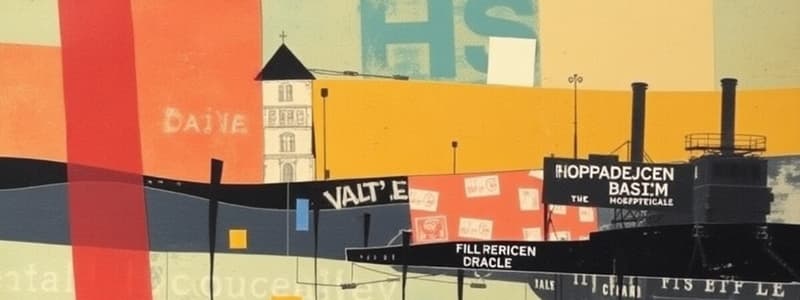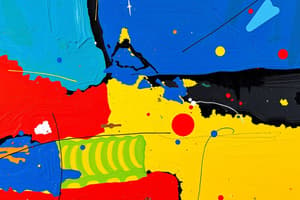Podcast
Questions and Answers
What is one major function of art?
What is one major function of art?
- Aesthetic Pleasure (correct)
- Mathematical Analysis
- Economic Profit
- Scientific Discovery
Which of the following is NOT considered a medium of art?
Which of the following is NOT considered a medium of art?
- Technological Innovations (correct)
- Literary Arts
- Performing Arts
- Visual Arts
Which art movement is characterized by its focus on humanism and perspective?
Which art movement is characterized by its focus on humanism and perspective?
- Modernism
- Renaissance (correct)
- Postmodernism
- Romanticism
What element of art defines shapes and forms?
What element of art defines shapes and forms?
Which principle of art involves the distribution of visual weight?
Which principle of art involves the distribution of visual weight?
What is a characteristic feature of Surrealism?
What is a characteristic feature of Surrealism?
Which of the following is NOT a category of art?
Which of the following is NOT a category of art?
What artistic technique is focused on capturing light and color to depict moments?
What artistic technique is focused on capturing light and color to depict moments?
Flashcards are hidden until you start studying
Study Notes
Definition of Art
- Expression of Human Experience: Art represents emotions, ideas, and perceptions.
- Mediums: Can include visual arts (painting, sculpture), performing arts (theater, dance), literature, and music.
Functions of Art
- Aesthetic Pleasure: Creates beauty and engages senses.
- Communication: Conveys messages and evokes emotions.
- Cultural Reflection: Represents cultural identity and historical context.
- Social Commentary: Challenges societal norms and brings awareness to issues.
- Therapeutic: Used in healing practices and personal expression.
Major Categories of Art
- Visual Arts: Painting, drawing, sculpture, photography, and mixed media.
- Performing Arts: Dance, theater, film, and music.
- Literary Arts: Poetry, prose, and drama.
- Applied Arts: Design aspects like fashion, graphic design, and architecture.
Key Art Movements
- Renaissance: Focus on humanism, perspective, and naturalism.
- Baroque: Dramatic use of light, emotion, and grandeur.
- Romanticism: Emphasis on emotion, nature, and individualism.
- Modernism: Break with tradition; abstraction and experimentation.
- Postmodernism: Diverse styles, irony, and questioning of art’s purpose.
Elements of Art
- Line: Defines shapes and forms; can convey emotion.
- Shape: Geometric or organic forms that create structure.
- Color: Influences mood and perception, has properties like hue, saturation, and value.
- Texture: Surface quality; can be actual or implied.
- Space: Use of depth, perspective, and composition.
Principles of Art
- Balance: Distribution of visual weight; types include symmetric and asymmetric.
- Contrast: Juxtaposition of different elements to highlight differences.
- Emphasis: Drawing attention to a focal point.
- Movement: Guide the viewer’s eye through the artwork.
- Rhythm: Repetition of elements to create a sense of movement.
Artistic Techniques and Styles
- Realism: Depiction of subjects as they appear in everyday life.
- Impressionism: Focus on light and color, capturing moments in time.
- Abstract: Use of shapes, colors, and forms to create compositions independent of visual references.
- Surrealism: Dream-like scenes and bizarre, imaginative elements.
Notable Artists
- Leonardo da Vinci: Master of the Renaissance; known for "Mona Lisa" and "The Last Supper."
- Vincent van Gogh: Post-Impressionist known for bold colors and expressive brushwork.
- Pablo Picasso: Co-founder of Cubism; known for "Guernica" and diverse styles.
- Frida Kahlo: Renowned for self-portraits and exploration of identity and pain.
Art Analysis
- Contextual Analysis: Understanding the historical and cultural background of the artwork.
- Formal Analysis: Examining the visual elements and principles used.
- Thematic Analysis: Exploring the underlying themes and messages.
Conclusion
- Art is a multifaceted field that encompasses various forms and functions, reflecting humanity's creativity and expression across cultures and time.
Definition of Art
- Art is a form of expression showcasing human experiences, ideas, and perceptions.
- It manifests in various mediums including visual arts, performing arts, literature, and music.
Functions of Art
- Creates beauty and engages senses, known as aesthetic pleasure.
- Conveys messages and evokes emotions, playing a role in communication.
- Represents cultural identity and historical context, reflecting the culture it originates from.
- Challenges societal norms and brings awareness to social issues, acting as social commentary.
- Can be used in healing practices and acts as a tool for individual expression, serving a therapeutic purpose.
Major Categories of Art
- Visual Arts encompass painting, drawing, sculpture, photography, and mixed media.
- Performing Arts consist of dance, theater, film, and music.
- Literary Arts include poetry, prose, and drama.
- Applied Arts focus on design aspects such as fashion, graphic design, and architecture.
Key Art Movements
- Renaissance art emphasized humanism, perspective, and naturalism, bringing a focus on the human form.
- Baroque art employed the use of light, emotion, and grandeur to create a sense of drama.
- Romanticism prioritized emotion, nature, and individualism, expressing personal feelings and experiences.
- Modernism broke with traditional art forms, favoring abstraction and experimentation in various styles.
- Postmodernism embraced diverse styles, irony, and questioned the purpose of art, challenging established norms.
Elements of Art
- Line is used to define shapes and forms, often conveying emotions.
- Shape refers to both geometric and organic forms, creating structure within a piece.
- Color influences mood and perception, with properties like hue, saturation, and value.
- Texture refers to the surface quality of an artwork, which can be actual or implied.
- Space is how depth, perspective, and composition are utilized within a piece.
Principles of Art
- Balance refers to the visual weight distribution, with types including symmetric and asymmetric.
- Contrast utilizes the juxtaposition of different elements, to highlight differences.
- Emphasis is used to draw attention to a specific focal point in an artwork.
- Movement guides the viewer's eye through the piece, creating a sense of flow.
- Rhythm is the repetition of elements within a piece to create a sense of movement.
Artistic Techniques and Styles
- Realism depicts subjects as they appear in everyday life, aiming for accuracy in representation.
- Impressionism focuses on capturing moments in time by emphasizing light and color.
- Abstract art uses shapes, colors, and forms to create compositions independent of visual references.
- Surrealism creates dreamlike scenes incorporating bizarre, imaginative elements.
Notable Artists
- Leonardo da Vinci, a master of the Renaissance, is known for "Mona Lisa" and "The Last Supper".
- Vincent van Gogh, a Post-Impressionist painter, is known for his bold colors and expressive brushwork.
- Pablo Picasso, co-founder of Cubism, known for "Guernica" and diverse, experimental styles.
- Frida Kahlo, renowned for self-portraits, explored themes of identity and pain in her work.
Art Analysis
- Contextual analysis involves understanding the artwork's historical and cultural background.
- Formal analysis examines the visual elements and principles used within the piece.
- Thematic analysis explores the artwork's underlying themes and messages.
Conclusion
- Art is a multifaceted field encompassing diverse forms and functions. It acts as a reflection of humanity's creativity and expression across time and cultures.
Studying That Suits You
Use AI to generate personalized quizzes and flashcards to suit your learning preferences.




